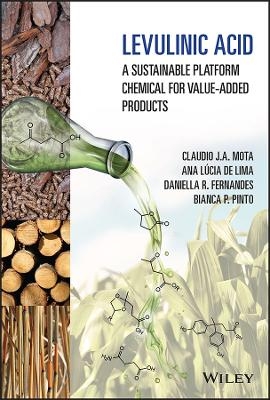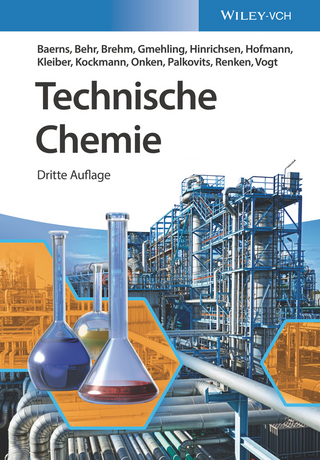
Levulinic Acid
John Wiley & Sons Inc (Verlag)
978-1-119-81466-5 (ISBN)
Use of fossil fuels and their derivatives has been one of the major drivers of climate change. This ongoing crisis has driven a global search for biofuels and biomass-derived chemicals which can serve as the basis for sustainable and renewable industry. One such ‘platform molecule’ is levulinic acid, whose derivatives are increasingly replacing traditional fossil-derived chemicals. The importance of levulinic acid for renewable industry is therefore only growing.
Levulinic Acid: A Sustainable Platform Chemical for Value-Added Products provides a book-length introduction to this chemical and its derivatives, like the levulinates, for which applications include fuel additives, food and cosmetic preservatives, flavors, solvents, and more. The book surveys the production routes and necessary technologies involved in the production of levulinic acid, as well as its current and potential applications and typical chemical reactions. It provides a critical introduction to a potentially rich source of alternative industrial material.
Levulinic Acid readers will also find:
Production routes from different biomass materials
Treatment of both organic and inorganic levulinates
Extensive discussion of levulinic acid hydrogenation
Other derivatives formed upon reaction at the keto-functionality
Levulinic Acid is the first book on this subject, ideal for researchers and industry professionals in green chemistry and sustainable/renewable production, as well as regulators and policymakers with a focus on the relevant industries.
Claudio J.A. Mota, PhD, is Professor of Chemistry and Chemical Engineering and head of the Institute of Chemistry at the Federal University of Rio de Janeiro, Brazil. He has taught and published extensively on green chemistry, catalysis, biomass conversion, as well as CO2 capture and conversion. Ana Lúcia de Lima, PhD, is Associate Professor at the Institute of Chemistry, Federal University of Rio de Janeiro, Brazil. Her research concerns synthesis of materials for CO2 capture, biomass conversion, and catalysis. Daniella R. Fernandes, PhD, is Associate Professor at the Institute of Chemistry, Federal University of Rio de Janeiro, Brazil. Her research concerns development of materials for biomass transformation and carbon capture. Bianca P. Pinto, PhD, is a researcher at the Laboratory of Reactivity of Hydrocarbons, Biomass and Catalysis, Federal University of Rio de Janeiro, Brazil. She is also the co-founder of CarbonAir Energy, a startup devoted to sustainable energy. Her research focuses on CO2 capture and biomass transformation.
About the Authors ix
Preface xi
1 Levulinic Acid – History, Properties, Global Market, Direct Uses, Safety 1
1.1 History and Properties 1
1.2 Global Market 8
1.3 Direct Uses 10
1.4 Toxicity of Levulinic Acid and Inorganic Levulinates 12
1.5 Concluding Remarks 13
References 15
2 Production and Technological Routes 19
2.1 Production and Technological Routes from Biomass 19
2.2 Pretreatment of Lignocellulosic Biomass 23
2.2.1 Physical Pretreatment 23
2.2.1.1 Mechanical 24
2.2.1.2 Microwave 25
2.2.1.3 Ultrasound 25
2.2.2 Chemical Pretreatment 25
2.2.2.1 Acid Hydrolysis 25
2.2.2.2 Alkaline Hydrolysis 26
2.2.2.3 Ionic Liquids 27
2.2.2.4 Organosolv 27
2.2.3 Physicochemical Pretreatment 28
2.2.3.1 Steam Explosion (SE) 29
2.2.3.2 Liquid Hot Water (LHW) 29
2.2.3.3 Ammonia Fiber Expansion (AFEX) 30
2.2.3.4 Supercritical CO 2 Explosion 30
2.2.4 Biological Pretreatment 31
2.3 Production of Levulinic Acid from Lignocellulosic Biomass 32
2.3.1 Processes for LA Production: Homogeneous Catalysts 35
2.3.2 Processes for LA Production: Heterogeneous Catalysts 38
2.3.3 Processes for LA Production: Biphasic Systems 40
2.3.4 The Biofine Process of LA Production 41
2.3.5 Downstream Process of LA Recovery 42
2.4 Commercial Plants for the Production of LA 44
2.5 Conclusion 47
References 47
3 Levulinate Derivatives – Main Production Routes and Uses of Organic and Inorganic Levulinates Derivatives 65
3.1 Main Production Routes 65
3.1.1 Esterification of Levulinic Acid 65
3.1.2 Direct Production from the Alcoholysis of Polyschacarides 71
3.1.3 Alcoholysis of Furfural 76
3.1.4 Alcoholysis of 5-Hydroxymethyl Furfural 82
3.1.5 Production of Levulinate Inorganic Salts 86
3.2 Importance and Market of the Levulinate Derivatives 87
3.3 Uses of Organic Levulinate Derivatives 88
3.3.1 Food and Cosmetic 88
3.3.2 Fuel Additives 89
3.3.3 Plasticizers 90
3.3.4 Solvents 91
3.4 Uses of Inorganic Levulinate Derivatives 93
3.4.1 Antifreeze Additive 93
3.4.2 Cosmetic, Pharmaceutical, and Food 93
3.4.3 Miscellaneous Applications 94
3.5 Conclusion 95
References 96
4 Levulinic Acid Hydrogenation 107
4.1 Levulinic Acid Hydrogenation Products 107
4.1.1 γ-Valerolactone (GVL) 107
4.1.1.1 GVL Versus Ethanol 111
4.1.1.2 2-Methyl-tetrahydrofuran (2-MTHF) 111
4.1.1.3 1,4-Pentanediol (1,4-PDO) 112
4.1.1.4 Alkyl Valerates 113
4.2 Performance of GVL as Fuel Additive 113
4.3 Levulinic Acid to γ-Valerolactone 114
4.3.1 Conversion of GVL into 1,4-PDO and 2-MTHF 115
4.3.2 GVL to Butenes and Hydrocarbons 117
4.4 Homogeneous and Heterogeneous Catalysts for the Efficient Conversion of LA to GVL 121
4.4.1 Precious Metal Catalysts 121
4.4.2 Nonprecious Metal Catalyst 125
4.4.2.1 Copper-Based Catalysts 125
4.4.2.2 Nickel-Based Catalysts 127
4.4.2.3 Zirconium-Based Catalysts 130
4.4.2.4 Iron-Based Catalysts 130
4.5 Heterogeneous Catalysts for the Conversion of LA and GVL to 1,4-PDO and 2-MTHF 132
4.6 Types of Hydrogenating Agents 135
4.7 Patent Search of LA Hydrogenation 137
4.8 Conclusion 138
References 138
5 Carbonyl Reactions of Levulinic Acid – Ketals and Other Derivatives Formed Upon Reaction with the Carbonyl Group of Levulinic Acid. Production Routes, Technologies, and Main Uses 149
5.1 Levulinc Acid Ester Ketals Main Routes 150
5.1.1 Levulinic Acid Ester Ketals Main Uses 153
5.2 Succinic Acid 158
5.2.1 Petrochemical and Biotechnological Routes 158
5.2.2 Levulinic to Succinic Acid 163
5.2.3 Succinic Acid Main Uses 164
5.3 δ-Aminolevulinic Acid (DALA) Main Routes 167
5.3.1 δ-Aminolevulinic Acid Main Uses 169
5.4 5-Methyl-N-Alkyl-2-Pyrrolidone Main Routes 171
5.4.1 5-Methyl-N-Alkyl-2-Pyrrolidone Main Uses 177
5.5 Diphenolic Acid Main Routes 179
5.5.1 Diphenolic Levulinic Acid Main Uses 181
5.6 Conclusion 185
References 185
6 Levulinic Acid in the Context of a Biorefinery 197
6.1 Biorefinery 197
6.2 Sugar-Based Biorefinery 198
6.3 Levulinc Acid and Levulinates from a Sugar Cane Biorefinery 200
6.4 Production of γ-Valerolactone in a Sugar Cane Biorefinery 201
6.5 LA in the Context of a Biodiesel Plant 204
6.6 Conclusions 206
References 207
Index 209
| Erscheinungsdatum | 27.01.2023 |
|---|---|
| Verlagsort | New York |
| Sprache | englisch |
| Maße | 152 x 229 mm |
| Gewicht | 454 g |
| Themenwelt | Naturwissenschaften ► Chemie ► Technische Chemie |
| Technik | |
| ISBN-10 | 1-119-81466-9 / 1119814669 |
| ISBN-13 | 978-1-119-81466-5 / 9781119814665 |
| Zustand | Neuware |
| Informationen gemäß Produktsicherheitsverordnung (GPSR) | |
| Haben Sie eine Frage zum Produkt? |
aus dem Bereich


